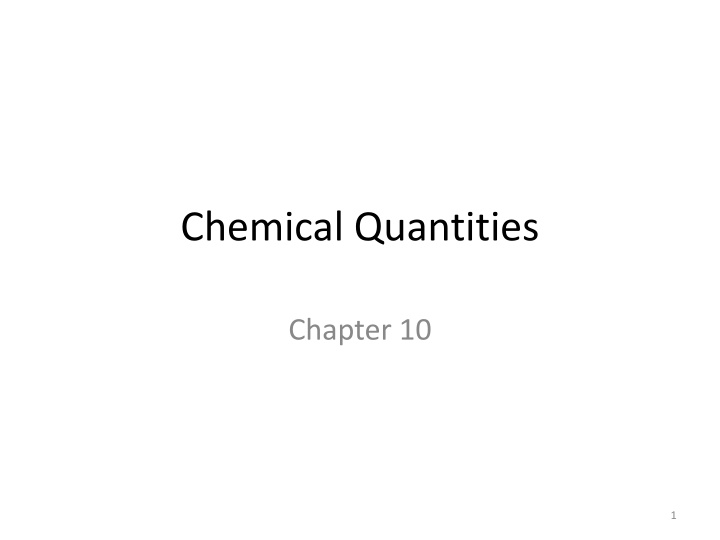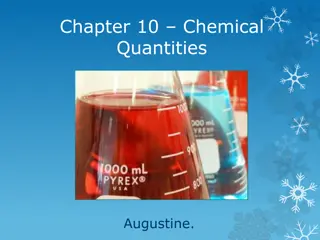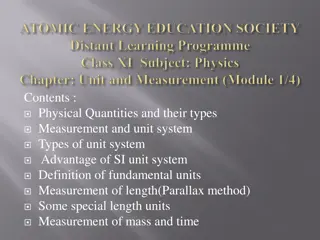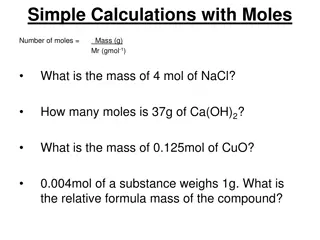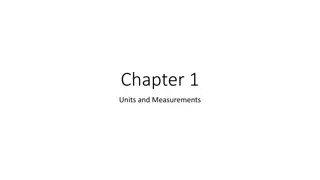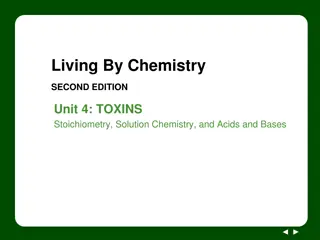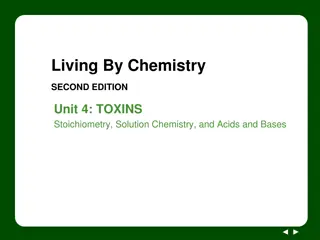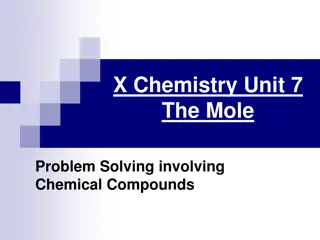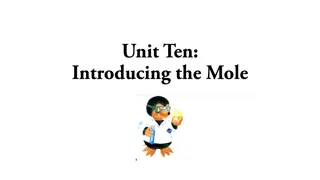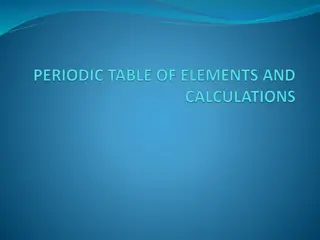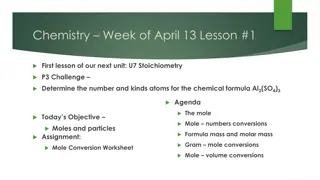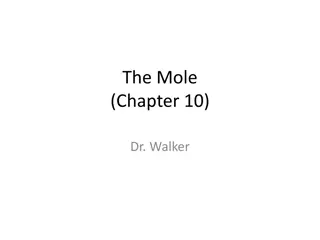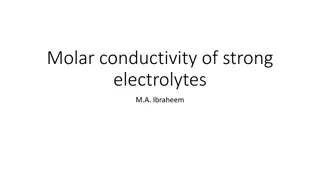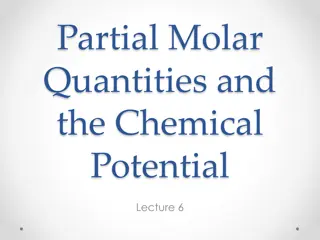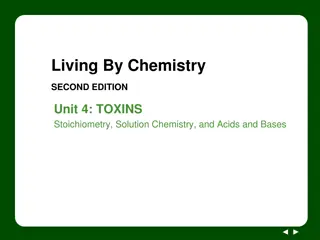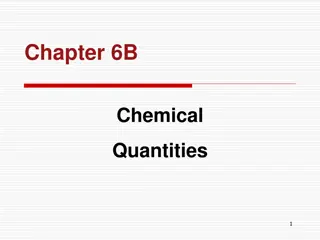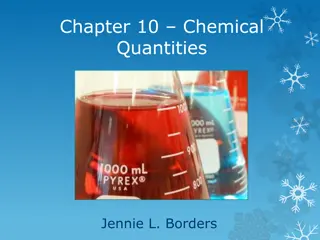Chemical Quantities and Molar Mass
Discover the concept of chemical quantities, molar mass, and conversion statements in chemistry. Learn how to calculate molar mass for compounds, apply significant figure rules, and convert between different units using mole as a key measurement. Explore one-step and two-step conversion examples for practical understanding.
Download Presentation

Please find below an Image/Link to download the presentation.
The content on the website is provided AS IS for your information and personal use only. It may not be sold, licensed, or shared on other websites without obtaining consent from the author.If you encounter any issues during the download, it is possible that the publisher has removed the file from their server.
You are allowed to download the files provided on this website for personal or commercial use, subject to the condition that they are used lawfully. All files are the property of their respective owners.
The content on the website is provided AS IS for your information and personal use only. It may not be sold, licensed, or shared on other websites without obtaining consent from the author.
E N D
Presentation Transcript
Chemical Quantities Chapter 10 1
Molar Mass Molar mass is the sum of atomic masses of the elements in the compound. You MUST take into account the number of atoms of each element. Example: Ca3(PO4)2 Ca 3(40.08) P 2(30.97) +O 8(16.00) 310.18 g Ca3(PO4)2 Significant figure rules: when adding or subtracting keep the smallest number of decimal places. The number of atoms is a counted quantity and has infinite significant figures. 2
Equality Statements Chemistry requires converting between different units of measure. Mole (mol) is the amount of a substance and can be used to show relationships between other units. 1 mol = 22.4 L {of any gas at STP} 1 mol = 6.02 x 1023 particles (ptl) 1 mol = molar mass g 3
Equality Statements Note STP means standard temperature and pressure. Which is 1 ATM and 273 K Molar mass is measured in grams and students must find it for each chemical formula. Particles can include: Atoms (unique to elements) Molecules (unique to covalent compounds) (mlc) Ions (unique for ions) Formula Units (unique for ionic compounds) (F.U.) 4
One Step conversions Chemistry conversions are all about canceling out the undesired unit to get the desired unit. When doing conversion you MUST show Numbers Units {mol, mlc, F.U, g, L} Chemical Formulas {example: Ca3(PO4)2} Steps 1. Write number and unit given in the problem 2. Multiply by a fraction so that units cancel What every your getting rid of goes on bottom, what every our going to goes on top. 3. Add the correct numbers form your equality statments. 5
One Step Conversions All examples are for Ca3(PO4)2 where 1 mol Ca3(PO4)2 = 310.18 g ??3(??4)2 Example 1: find number of grams in 1.846 moles 1.846 ?????3(??4)2 310.18 ???3(??4)2 1 ?????3(??4)2 Example 2: find number of moles in 267.53 g ??3(??4)2 1 ?????3(??4)2 310.18???3(??4)2 Example 3: find number of moles in 1.23 x 1025 F.U. Ca3(PO4)2 1.23 1025?.?.??3(??4)2 6.02 1023?.?.??3(??4)2 NOTE that the staring unit determines the location of the units in the conversion fraction. = 572.6 ???3(??4)2 267.53???3(??4)2 = 0.86250 ?????3(??4)2 1 ?????3(??4)2 = 20.4 ?????3(??4)2 6
Two Step Conversion Only allowed to convert using the equality statements below 1 mol = 22.4 L {of any gas at STP} 1 mol = 6.02 x 1023 particles (ptl) 1 mol = molar mass g When going from grams to L or particles to grams (ect) it requires two conversion factions. The order of the units in the fractions are determined by what you are starting with and what you want to go to. 7
Two Step Conversion Raines Mole Map Each bridge is a fraction! Mole is always 1 Volume is always 22.4 L Particles is always 6.02 x 1023 ptl Mass is always molar mass of compound/element in grams. 8
Two Step Conversion Example 1 Find the number of particles in 0.0534 L of carbon dioxide Use map to see how many steps it will take to complete conversion. Two bridges means two fractions. Write given number and unit with chemical formula then set up fractions so that units cancel. 0.0534 ? ??2 ?????2 ???2 equality statements Turn name into formula: carbon dioxide is CO2 ?????2 ?????2 = fill in fractions with # from 6.02 1023??? ??2 1 ??? ??2 0.0534 ? ??2 1 ?????2 = 1.44 1021 ??? ??2 22.4 ???2 9
Two Step Conversion Example 2 If you have 55.6 g of propane (C3H8) how liters do you have? This problem involves mass and you must calculate molar mass of the compound. C= 3(12.01g) H= 8(1.01g) Total: 3(12.01g)+ 8(1.01g)=23.09 g C3H8 This means 1 mol C3H8 = 23.09 g C3H8 Set up conversion by canceling units. 35.6? ?3?8 ????3?8 ??3?8 ??? ?3?8 complete fractions with numbers from equality statements 1 ??? ?3?8 23.09? ?3?8 1 ??? ?3?8 ? ?3?8 22.4 ? ?3?8 55.6? ?3?8 = 53.9 ? ?3?8 10
Two Step Conversion Example 1 11
Percent composition Percent composition is the relative amount of the elements in a compound The percent by mass of an element in a compound is the number of grams of the element divided by the mass in grams of the compound, multiplied by 100 ???? ?? ?????? ???? ?? ???????? 100 % ???? ?? ??????? = You can check if you did correctly by adding up the % compositions. It should equal 100 (or be very close 99.98 to 100.02 range): 13
Percent Composition Example 1 Find the percent composition of each element in H2O Mass of H2O = 2(1.01)+1(16.00)=18.02g Mass of hydrogen in H2O = 2(1.01) =2.02 g % comp of hydrogen = 2.02g/18.02g x 100= 11.21% hydrogen Mass of oxygen in H2O = 1(16.00)=16.00 g % comp of oxygen = 16.00g/18.02g x 100= 88.79% oxygen Check: 11.21% hydrogen + 88.79% oxygen = 100 % total so work was correct 14
Percent Composition Example 2 Find the percent composition of each element in Ca3(PO4)2 Mass of Ca3(PO4)2= 3(40.08) + 2(30.97) + 8(16.00)= 310.18 g Mass of Calcium in Ca3(PO4)2 = 3(40.08) = 120.24 g % comp of calcium = 120.24g/310.18g x 100 = 38.76 % Ca Mass of phosphorous in Ca3(PO4)2 = 2(30.97) = 61.94 g % comp of phosphorous = 61.94 / 310.18 x 100 = 19.97% P Mass of oxygen = 8 (16.00) = 128.00 g % comp of oxygen = 128.00g /310.18g x 100 = 41.27% O Check: 38.76 % + 19.97% + 41.27% = 100% 15
Percent composition ???? ?? ??????? ???? ?? ???????? 100 % ??????????? ?? ??????? = or # ????? (?????? ????) ???? ?? ???????? % ??????????? ?? ??????? = ? 100 remember to check your work by adding up the percentages 16
Percent composition with masses Finding percent composition if given the mass of the elements in the compound is the same process. ???? ?? ??????? ???? ?? ???????? 100 % ??????????? ?? ??????? = Example: find the percent composition of each element if the compound containing 27.53 g of Ca and 48.72 g of Cl 27.53 % ?? = 27.53+48.72? 100= 36.10 % Ca 48.72 27.53+48.72? 100= 63.90 % Cl % ?? = 17
Using Percent Composition If you know the percent composition (or can calculate it) it can be used to find the mass of an element in compound. total Mass (% in decimal form) = mass of element Example: You have a 58.24 g sample of a substance that contains 25.0% hydrogen. What is the mass of hydrogen in the sample 58.24g (.0250)=14.56 g hydrogen 18
Using Percent Composition If give the chemical name or formula you will need to find the percent composition of the desired element. Example: You have a 27.80 g sample of aluminum sulfide, what is the mass of aluminum in the sample. Al2S3 Molar mass: 2(26.98) + 3(32.07) = 150.17g % Al = 2 26.98 ? 150.17? 100 = 35.93 % Al 27.80g (0.3593) = 9.99 g of sample is Al 19
Empirical formula Empirical formula gives the lowest whole- number ratio of the atoms of the elements in a compound An empirical formula may or may not be the same at a molecular formula The empirical formula of a compound shows the smallest whole-number ratio of the atoms in the compound Example: methane is C2H6, empirical formula would be CH3. 20
Finding Empirical Formulas 1. IF given % assume you have a 100 g sample and the % turns into grams. 2. Turn grams of each element into moles of the element. (use mass to mole conversion). 3. Get whole number ratio of elements. (Divide all by smallest # of moles) 4. Use whole numbers as subscripts in chemical formulas 21
Empirical formula example 1 Find empirical formula for compound containing 67.7% mercury, 10.8% sulfur, and 21.6% oxygen. 1. 67.7 g Hg, 10.8 g S, 21.6 g O 2. Mole Hg= 67.7gx (1mol/200.59g) =0.34 molHg Mol S = 10.8 g x (1mol/32.07g)=0.34 mol S mol O = 21.6 g x (1mol/16.00g)= 1.35 mol O 3. # of Hg = (0.34/0.34) = 1 Hg # of S = (0.34/0.34) = 1 S # of 0 = (1.35/0.34) = 3.97 = 4 O 4. HgSO4 22
Empirical Formula When you find the ratio of atoms be on the look out for numbers that indicate you have to multiply. Ratios of 1.5, 2.5 . Indicate you need to multiply by 2 Ratios of 1.33, 2.33 indicate you need to multiply by 3 If your ratio is very close to the whole number round to the whole number. 1.02 would round to 1, 2.97 would round to 3. 23
Empirical formula example 2 Find empirical formula for compound containing 62.1%C, 13.8 % H, 24.1%N. 1. 62.1 g C, 13.8 g H, 24.1 g N 2. mol C= 62.1g 1 ??? 12.01 ?=5.17 mol C mol H = 13.8 g 1 ??? 1.01 ?13.66 mol H mol N = 24.1 g x 1 ??? 14.01 ?1.72 mol N 3. # of C = (5.17/1.72) = 3.01 C = 3 C # of H = (13.66/1.72)= 7.94 H = 8 H # of N = (1.72/1.72) = 1 N 4. C3H8N 24
Molecular formula Molecular formula is also known as the TRUE formula. In order to find molecular formula you MUST know the MOLAR MASS of the compound. You must also calculate the value that the subscripts need to be multiplied by. ????? ???? ????????? ???? Multiplier = 25
Molecular Formula Example 1 Example: find the molecular formula if the molar mass of the compound is 174.36 and it s empirical formula is C3H8N Empirical formula = C3H8N has mass of58.12g Multiplier = 174.36 58.12= 3 {multiply each subscript by this number} Molecular formula = C9H24N3 26
Example 2 Find the empirical and molecular formula for a compound containing 40.0% C, 6.7% H, 53.3% O and a molar mass of 90.09 g. 1st use % to find empirical formula 1 ??? 12.01 ?= 3.33 ??? ? 6.7 g H 1 ??? 1.01 ?= 6.63 ??? ? 1 ??? 16.00 ?= 3.33 ??? ? Need to find whole number ratio of mole so divide each by smallest number of moles 40.0 g C 53.3 g O 27
Example 2 Whole # ratio 1 ??? 12.01 ?= 3.33 ??? ? 3.33 = 1 ? 6.7 g H 1 ??? 1.01 ?= 6.63 ??? ? 3.33 = 1.99 = 2 ? 1 ??? 16.00 ?= 3.33 ??? ? 3.33 = 1 O Empirical Formula = CH2O Empirical Mass = 12.01 + 2(1.01) + 16.00 = 30.03 Multiplier = 90.09? 30.03 ?= 3 Molecular formula = C3H6O3 40.0 g C 53.3 g O 28
